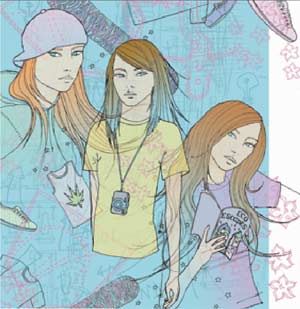Freesports are proud of their place on the cutting edge of cool, but what does it take to stay ahead of the game?
Words by Cathy Struthers
Illustration by Erica Sharp

They are the voyeurs of cool. They travel the globe, soak up street culture, fill the front seats at fashion shows and photograph people as they shop, eat and party in their never-ending quest for the Next Big Thing. They are the coolhunters, the hipsters whose job it is to predict the future of cool. You may not know it yet, but they’ve already decided what you’ll be wearing, in what colour and where you’ll be wearing it, as far ahead as January 2008 ( in case you’re wondering, that’ll be lightweight, fluid knits with coloured denim in midnight electric blue as you swan through the soon-to-be-hip streets of Lisbon).
The coolhunters are the eyes and ears of youth culture, and right now, it’s the action sports lifestyle that they’ve got their finger on the pulse of.
‘The neat thing about the action sports industry is that it’s right out there at the cutting edge at the moment,’ says Kristin Young, etnies girl footwear designer and product manager at Sole Technology. ‘Even high end fashion brands such as Tommy Hilfiger and Marc Jacobs are drawing inspiration from action sports.’
And that’s good news for maintaining the cool status of core freesports brands.

‘It’s vital for action sports brands to be perceived as cool,’ explains Danielle Sellwood, Active Sports editor for international trend spotters WGSN (Worth Global Style Network). ‘The sports industry survives on the lifestyle aspirations and image of the sport. In the case of action sports their image is young, dynamic, anarchic, fun and free. Compare this image with that of a traditional sport like running which has a more competitive or recreational image. If the brand can project a very cool image then people will want to buy into it and achieve cool status by association.’
All about image
So how do they do it? How do snowboard brand Burton or surf brand Roxy tread the fine line between cool and overkill? And how do emerging freesports brands make sure they set trends rather than follow them?
‘Some brands do it by simply being the market leaders,’ says Sellwood. ‘Like Burton, for example. They may be fairly mainstream but the fact that they were the frontrunners and pioneers gives them a genuine heritage and, therefore, respect.’

Other brands, like Volcom, achieve their status by being more underground. They don’t let the press see what they are doing, they control all their imagery, they show it how they want it to be seen. They also give crazy parties and project the image of being the bad boys (even though in reality they are a fairly sizeable and organised company).
It’s good news for maintaining the cool status of core freesports brands.
‘Marketing is the key aspect, more so even than the designs of the clothing and hardware,’ explains Sellwood. ‘I was once at the X-games in San Francisco and a helicopter hovered above the crowd and dropped hundreds of dollar bills into the crowd. We got one and realised it was a real dollar bill but stamped with the brand’s logo – the kids were going wild for it and would always then associate that brand with a really cool stunt.’
But it’s not just about managing marketing. The product and designs have to be in tune with, or even ahead of, the current zeitgeist. And these days, where fads ping across continents and disappear just as quickly, trend spotters have got their work cut out for them. Since the Internet exploded, connecting everyone to everything in an instant, trends are moving faster than ever. A skirt appears on the catwalk in Milan, and a few weeks later an exact copy is for sale in your local high street.
‘Trend cycles are happening so much faster than ever before,’ reckons Young. ‘With the internet, even people in remote places can hit emerging trends as they happen. But this means that trends die faster too. Right now a trend lasts only about three to six months before it becomes too popular to be cool and is killed off.’

The Hunt
With most designers working more than a year ahead of a collection’s launch, keeping their finger on the pulse and staying one step ahead is essential, even if there’s a risk the trend could die too soon. Travel is a key element of staying on top of and predicting trends and designers hunt all over the globe to try and work out what’s on the up, where.
‘Each marketplace is really becoming its own niche now,’ says Young. ‘Trends are far less likely to be global these days, but you can get an idea of what’s up and coming just by looking in the right places. My favourite place to coolhunt is there street. You can look at what the fashion industry is doing and only get so much. What tells us much more is how people put things together on the street. Barcelona is my favourite place to trend spot in the street. I love the way the people there throw things together and there are some really cool action sports-inspired graffiti artists. It’s great to soak all that up.’
Immersing themselves in the media and magazines is another way to keep abreast of emerging trends. In LA, coolhunters head for the hyper-hip International Fashion Cafe, where they can chill out, people watch and wade through the international fashion magazines.
Simple people watching is often the most powerful prediction tool.
‘Trade shows, fashion shows, events and competitions are important too,’ adds Sellwood. ‘Sometimes we get a feel for something before it happens, sometimes there’s a logical progression, sometimes we make things happen purely by reporting on something we saw that we thought was cool.
‘Every now and then we spot something we love but if its a one-off its not really a trend, just a bit of off-the-wall creativity, so we will hold on to that image until we see more evidence of a similar trend. It can take six months for a trend to emerge to the status that we have enough evidence to label it a trend. Basically its just really extensive research and knowledge of what’s been before, plus a strong creative eye.’

But it’s on the street that the hottest trends emerge, so simple people watching is often the most powerful prediction tool. Some trend spotting agencies hunt out cool kids, the “trendsetters” to provide a bridge to street culture. These tend to be forward-thinking individuals who look outside their own backyard for inspiration and who is a leader within their own group.
US trend predictors Look Look, employ about 10,000 of these “trendsetters” or “correspondents” to report back to them with what’s happening on the street, who’s wearing what, what activities they’re doing and what music they’re listening to.
‘It’s giving insight into what’s real and not packaged, so it feeds itself,’ explains Sharon Lee. ‘We look for kids who are ahead of the pack, because they’ll influence what all the other kids do. We look for the 20 percent, the trendsetters, who are going to influence the other 80 per cent.’
What will be hot?
So what has all this research revealed for the next few seasons? We asked the coolhunters to spill their secrets and let us in on what trends we can expect to fall in love with.
Customisation is one key trend that’s on the up this year. Whether you’re after a one-off design for your new shoes or a pair of jeans, technological advances are making mass customisation easier than ever. Even big manufacturers like Nike are offering products that allow for personal expression.
‘Individuality is hugely important,’ says Sellwood. ‘Having your own views, ideas and style and being proud of who you are is always far cooler than following the crowd. But later this year we will see a move away from overdone customisation to more discreet and considered ideas.’
Etnies Girl has tapped into this trend too, with its Autumn 06 collection featuring shoes with an arts and craftsy theme. ‘We spotted that customisation is becoming a huge trend and everyone wants to personalise what they wear,’ explains Young. ‘But for Spring 07, we think freesports are going to merge much more with fashion and we will be launching a more exclusive fashion product. The fat puffy skate shoe is starting to get thinned out a bit and materials will cater for the more fashion conscious girl.’

This coming winter the neons and brights of last season will give way to more washed-out neutral, nature-inspired colours. But despite this trend towards more low-key effects, bling still seems to be big for winter 06/07, especially on the snowboard scene. B by Burton, the new women’s range, has plenty of Gucci-esque logo prints and gold trims. Adidas Eyewear has a foxy range of gold and chrome goggles and skis and snowboards are getting luxurious faux animal print and animal skin topsheets.
Eternally fashionable denim will also get a bit of a makeover come 2007.
Strong prints continue to be key for snowsports – think abstract camouflage, pinstripes, brightly coloured traditional checks and logo based repeated prints.
Even further into the future, the following winter (07/08) will see colours get warmer again, with blues, oranges and ambers looking like the hottest options. Hardware will succumb to the frost effect, with pale, milky, frosty colours coming to the fore. Print-wise, geometric shapes repeated in miniature across ski and snowboard outerwear looks set to be big, along with portraits and face graphics.

Although it will certainly be hot this winter, the following season might be time to finally ditch your homespun beanie though as bonnet-style hoods and structured balaclavas look set to make a more stylistic entrance.
Eternally fashionable denim will also get a bit of a makeover come 2007, with coloured denim looking like being especially big. ‘Coloured denim is a huge trend already in the Far East right now,’ says Sellwood. ‘It will take a year or so to make an appearance here though. Bright blue is a key colour, but so is easy-to-wear olive green.’
If you’d rather stick with denim colours, the ‘carrot top’ jeans (baggy at the top, skinny at the bottom) that will be everywhere this summer, will develop into jeans, cinched in with leather laces at the ankles.
On your feet, things will be simpler. Clean, plain and unfussy designs on streamlined, minimal shapes is the route trainers and skate shoes will be taking.
Keeping it real
If it sounds exhausting trying to stay abreast of the cutting edge, don’t worry. If there’s one thing cool isn’t, it’s contrived, and most coolhunters agree there are fewer rules for cool nowadays.

‘These days cool is more about being individual and creative,’ believe Sellwood. ‘Some people are really good stylists and can put together a look that works well for them but would look silly on someone else. I think as long as people are true to themselves and what they like they are far more likely to look cool, than if they just follow a trend in a literal sense.’
The same is true for freesports brands if they stay true to their heritage. ‘Our pro-riders as they are the life of what we do,’ explains Young. ‘We always listen to what they want and we use that as our edge.’
All rider-owned or rider-driven brands are cool in the eyes of those who care about their sport. ‘If they genuinely love their sport and support it then they will always have the support and respect of the consumer,’ says Sellwood. ‘If they are creative on top of that then they are super cool!’
Cool is what works for you. Fads are so yesterday.

